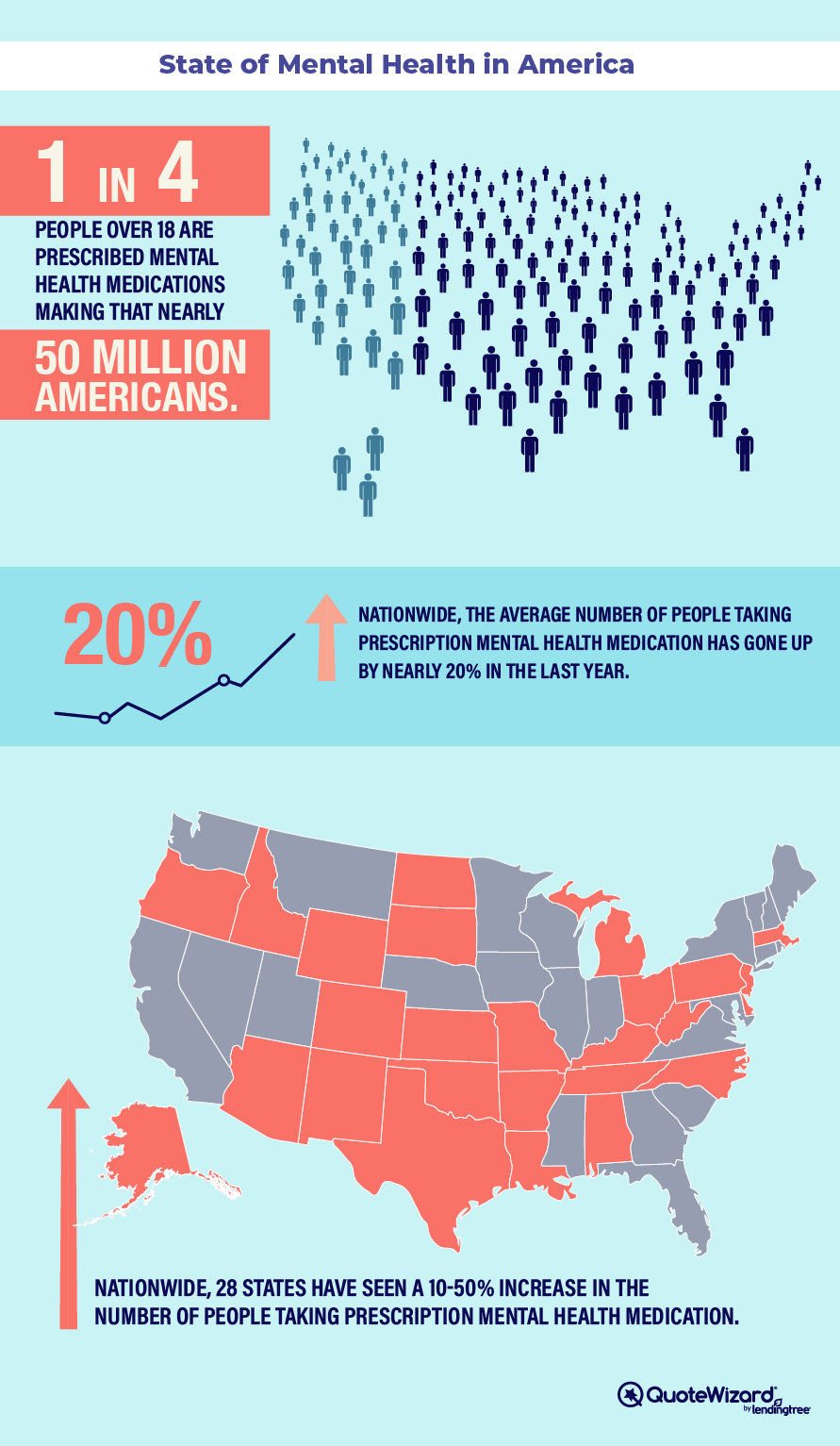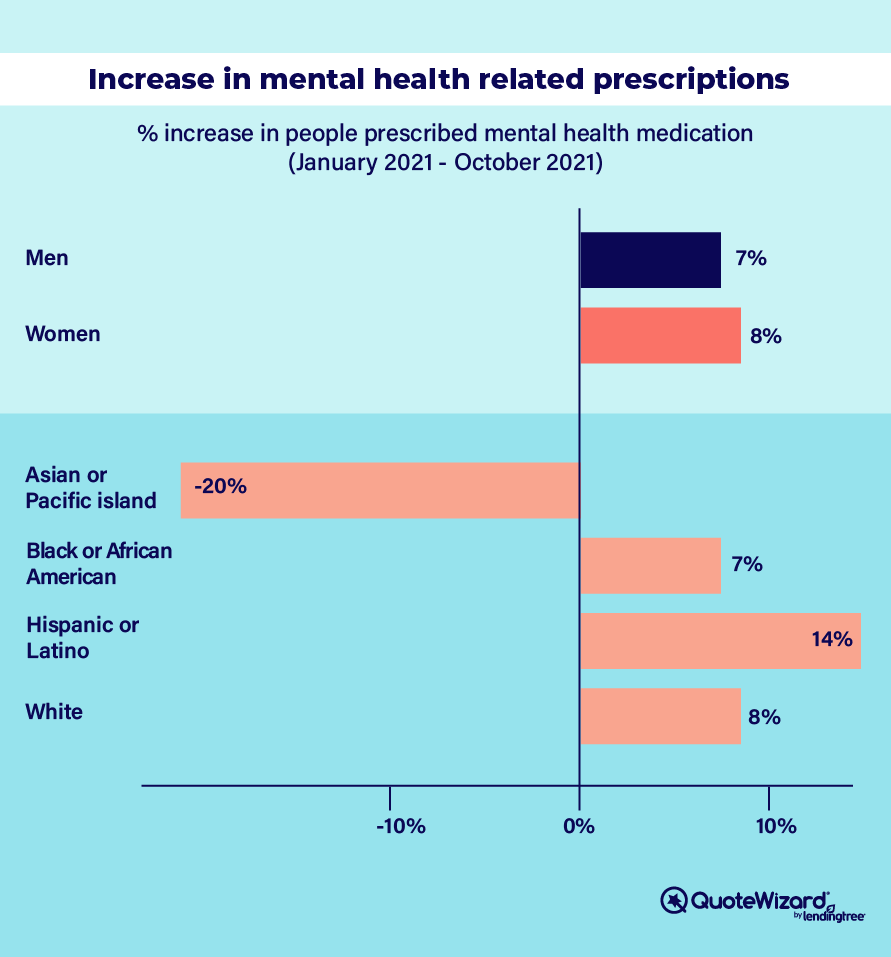COVID-19 hasn’t just affected people’s physical health. The pandemic has also had a profound and prolonged impact on people’s mental health. Over the last year, more and more people have reached out for help dealing with stress, anxiety or depression.
Our team of analysts found that the number of people taking prescription mental health medication has steadily increased since the beginning of the pandemic. More than 24% of Americans are now taking prescription mental health medication — that’s 1 out of every 4 people. These numbers should not be stigmatized or taken lightly because they point to the serious impact COVID-19 is having on Americans’ mental health.
Key findings:
- Nationwide, 28 states have seen 10%-50% increases in the number of people taking prescription mental health medication in the last year.
- Arkansas, New Mexico and New York had the largest increases in people taking mental health medication.
- Montana, Nevada and Hawaii saw the largest decreases in the number of people taking mental health medication.
- The number of women prescribed mental health medication increased by 8% over the last year.
- Nearly 1 in 4 people are currently taking prescription mental health medication.
Nationwide, the average number of people taking prescription mental health medication has gone up by nearly 20% since the beginning of the year. This increase, however, varies significantly from state to state.

The increase in prescriptions for mental health medications also crosses traditional demographic lines. We found a nearly 10% increase among men and women and within black and white communities. Hispanic communities meanwhile saw a 14% increase and Asian communities had a 20% decrease.
| State | % of people currently taking prescription mental health medication | % increase in people taking prescription mental health medication (January 2021 - Present) |
|---|---|---|
| Alabama | 29% | 26% |
| Alaska | 22% | 13% |
| Arizona | 23% | 20% |
| Arkansas | 34% | 34% |
| California | 15% | -9% |
| Colorado | 26% | 22% |
| Connecticut | 20% | -2% |
| Delaware | 22% | 13% |
| Florida | 17% | -16% |
| Georgia | 22% | 2% |
| Hawaii | 13% | -19% |
| Idaho | 25% | 15% |
| Illinois | 21% | -10% |
| Indiana | 28% | 7% |
| Iowa | 24% | -6% |
| Kansas | 26% | 20% |
| Kentucky | 29% | 13% |
| Louisiana | 31% | 25% |
| Maine | 23% | -6% |
| Maryland | 21% | 1% |
| Massachusetts | 24% | 13% |
| Michigan | 26% | 18% |
| Minnesota | 23% | -1% |
| Mississippi | 27% | 2% |
| Missouri | 28% | 17% |
| Montana | 18% | -29% |
| Nebraska | 26% | 5% |
| Nevada | 15% | -23% |
| New Hampshire | 26% | 6% |
| New Jersey | 21% | 27% |
| New Mexico | 22% | 42% |
| New York | 23% | 50% |
| North Carolina | 26% | 12% |
| North Dakota | 26% | 14% |
| Ohio | 26% | 32% |
| Oklahoma | 26% | 13% |
| Oregon | 26% | 24% |
| Pennsylvania | 28% | 16% |
| Rhode Island | 26% | -5% |
| South Carolina | 24% | -15% |
| South Dakota | 24% | 18% |
| Tennessee | 25% | 15% |
| Texas | 21% | 18% |
| United States | 24% | 20% |
| Utah | 27% | 8% |
| Vermont | 21% | 0% |
| Virginia | 20% | -3% |
| Washington | 22% | 0% |
| West Virginia | 32% | 24% |
| Wisconsin | 18% | -17% |
| Wyoming | 27% | 32% |

The rise in prescriptions for mental health medications coincides with a growing trend we have been following since before the COVID-19 pandemic began. According to the Centers for Disease Control and Prevention, the average number of people who took medication for mental health reasons was 15.8% in 2019. That same average is now 24%. The ongoing pandemic has been and continues to be a time of great uncertainty; people should be applauded for having the courage to reach out and ask for help. If you or someone you know is struggling during this difficult time, please consider reaching out to one of the organizations below.
National Institute of Mental Health (NIMH)
- 1 (866) 615-6464
- NIMH website
Substance Abuse and Mental Health Services Administration (SAMHSA)
- 1 (800) 662 - 4357 (24hrs)
- SAMHSA website
National Alliance on Mental Illness
- 1 (800) 950 - 6264
- info@nami.org
Most insurance plans cover some form of mental health care. Coverage varies, but this often includes access to therapy, counseling and prescription drug coverage. Additionally, both Medicare and all Affordable Care Act (ACA or Obamacare) marketplace plans are required to cover mental health services.
Methodology
To determine the percentage increase in the number of people taking prescription mental health medication, we analyzed Pulse Survey data from the Centers for Disease Control and Prevention. The data range went from January, 2021 to October 15, 2021.
References:
QuoteWizard.com LLC has made every effort to ensure that the information on this site is correct, but we cannot guarantee that it is free of inaccuracies, errors, or omissions. All content and services provided on or through this site are provided "as is" and "as available" for use. QuoteWizard.com LLC makes no representations or warranties of any kind, express or implied, as to the operation of this site or to the information, content, materials, or products included on this site. You expressly agree that your use of this site is at your sole risk.
